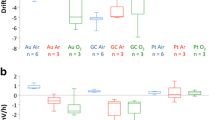Abstract
Potentiometric ion sensors were prepared from the conjugated polymer poly(3-octylthiopene) (POT). The influence of additional membrane components, including silver 7,8,9,10,11,12-hexabromocarborane (AgCB11H6Br6) and potassium tetrakis[3,5-bis(trifluoromethyl)phenyl]borate (KTpFPB) as lipophilic salts, and [2.2.2]p,p,p-cyclophane as silver ionophore, was studied. The membrane components were dissolved in chloroform and membranes were prepared by solution casting on glassy carbon disk electrodes. For comparison, POT-based potentiometric sensors were also prepared by galvanostatic electrosynthesis of POT from the 3-octylthiophene monomer. All the POT-based ion sensors fabricated by solution casting show Nernstian or slightly sub-Nernstian response to Ag+, even those based only on POT without any additional membrane components. The potentiometric response of electrochemically polymerized POT depends on the film thickness and the doping anion incorporated in the conducting polymer during polymerization. It is of particular importance that chemically synthesized undoped POT (without any additives) shows a sensitive and selective potentiometric response to Ag+ ions although UV-vis results show that POT remains in its undoped form, i.e., POT is not oxidized by Ag+. This indicates that undoped POT can exhibit good sensitivity and selectivity to Ag+ also in the absence of metallic silver in the polymer film. In this case, the potentiometric response is related to interactions between Ag+ and the conjugated polymer backbone.







Similar content being viewed by others
References
Mascini M, Liberti A (1970) Anal Chim Acta 51:231
Schmidt E, Pungor E (1971) Anal Lett 4:641
Veselý J, Jensen OJ, Nicolaisen B (1972) Anal Chim Acta 62:1
Liteanu C, Popescu IC, Ciovirnache V (1972) Talanta 19:985
Umezawa Y (eds) (1990) CRC handbook of ion-selective electrodes: selectivity coefficients, CRC Press Inc., Boca Raton
Bühlmann P, Pretsch E, Bakker E (1998) Chem Rev 98:1593
Umezawa Y, Bühlmann P, Umezawa K, Tohda K, Amemiya S (2000) Pure Appl Chem 72:1851
Cobben PLHM, Egberink RJM, Bomer JG, Bergveld P, Verboom W, Reinhoudt DN (1992) J Am Chem Soc 114:10573
Malinowska E, Brzózka Z, Kasiura K, Egberink RJM, Reindhoudt DN (1994) Anal Chim Acta 298:245
Kimura K, Yajima S, Tatsumi K, Yokoyama M, Oue M (2000) Anal Chem 72:5290
Mahajan RK, Kumar M, Sharma V, Kaur I (2001) Analyst 126:505
Shinohara T, Higuchi H, Senba Y, Ohto K, Yoshizuka K, Inoue K (2001) Anal Sci 17:889
Chen L, Ju H, Zeng X, He X, Zhang Z (2001) Anal Chim Acta 437:191
Lim SM, Chung HJ, Paeng K-J, Lee C-H, Choi HN, Lee W-Y (2002) Anal Chim Acta 453:81
Mahajan RK, Kaur I, Kumar M (2003) Sens Actuators B 91:26
Sil A, Ijeri VS, Srivastava AK (2001) Anal Sci 17:477
Bryce MR, Johnston B, Kataky R, Toth K (2000) Analyst 125:861
Mahajan RK, Parkash O (2000) Talanta 52:691
Amini MK, Ghaedi M, Rafi A, Mohamadpoor-Baltork I, Niknam K (2003) Sens Actuators B 96:669
Abbaspour A, Izadyar A, Shargi H (2004) Anal Chim Acta 525:91
Mahajan RK, Sood P, Mahajan MP, Singh P (2004) Anal Sci 20:1423
Bobacka J, Lahtinen T, Nordman J, Häggström S, Rissanen K, Lewenstam A, Ivaska A (2001) Electroanalysis 13:723
Bobacka J, Lahtinen T, Koskinen H, Rissanen K, Lewenstam A, Ivaska A (2002) Electroanalysis 14:1353
Bobacka J, Väänänen V, Lewenstam A, Ivaska A (2004) Talanta 63:135
Vázquez M, Bobacka J, Luostarinen M, Rissanen K, Lewenstam A, Ivaska A (2005) J Solid State Electrochem 9:312
Roncali J, Garreau R, Yassar A, Marque P, Garnier F, Lemaire M (1987) J Phys Chem 91:6706
Dietrich M, Heinze J, Heywang G, Jonas F (1994) J Electroanal Chem 369:87
Bobacka J, Lewenstam A, Ivaska A (1993) Talanta 40:1437
Lebedev MY, Lauritzen MV, Curzon AE, Holdcroft S (1998) Chem Mater 10:156
Umezawa Y, Umezawa K, Sato H (1995) Pure Appl Chem 67:507
Koryta J, Dvorak J, Kavan L (eds) (1993) Principles of electrochemistry, 2nd ed, Wiley, Chichester, p 38
Hotta S, Rughooputh SDDV, Heeger AJ, Wudl F (1987) Macromolecules 20:212
Latonen R-M, Kvarnström C, Ivaska A (2001) J Electroanal Chem 512:36
Manard MJ, Kemper PR, Bowers MT (2005) Int J Mass Spectrom 241:109
Acknowledgements
The authors are grateful to Dr. Carita Kvarnström for the fruitful discussions. Financial support from the National Technology Agency (TEKES) and the Academy of Finland are gratefully acknowledged. This work is part of the activities at the Åbo Akademi Process Chemistry Centre within the Finnish Centre of Excellence Programme (2000–2005) by the Academy of Finland.
Author information
Authors and Affiliations
Corresponding author
Additional information
Presented at the 4th Baltic Conference on Electrochemistry, Greifswald, 13–16, 2005
Rights and permissions
About this article
Cite this article
Vázquez, M., Bobacka, J. & Ivaska, A. Potentiometric sensors for Ag+ based on poly(3-octylthiophene) (POT). J Solid State Electrochem 9, 865–873 (2005). https://doi.org/10.1007/s10008-005-0031-9
Received:
Revised:
Accepted:
Published:
Issue Date:
DOI: https://doi.org/10.1007/s10008-005-0031-9




